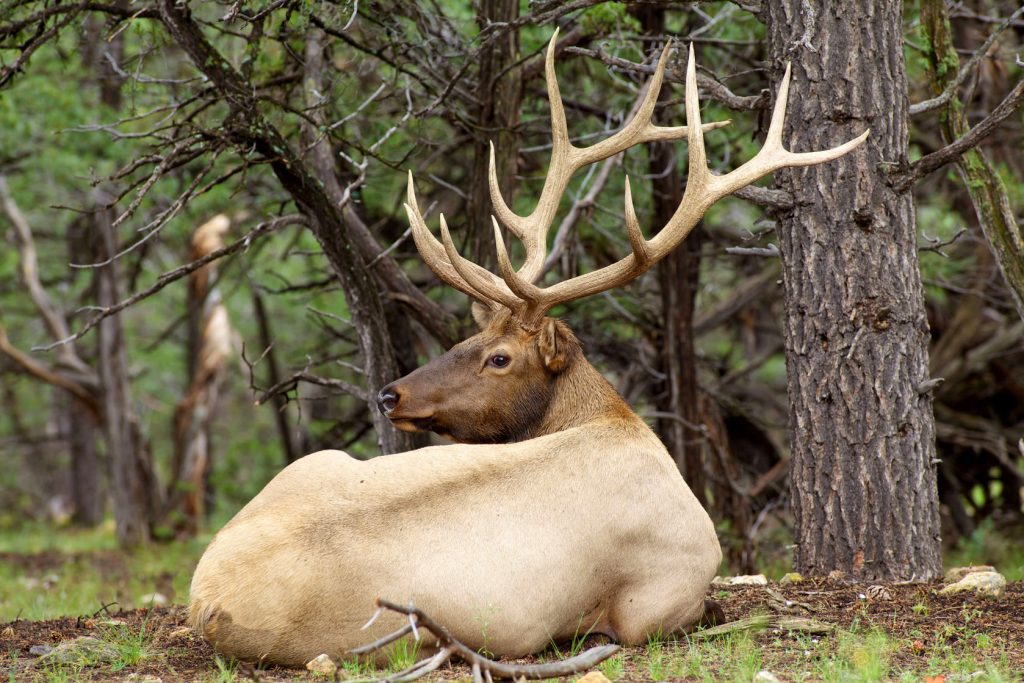
MODULE 6 - ELK HUNTING KNOWLEDGE
CHAPTER 2: A DAY IN THE LIFE OF AN ELK

Once you have located elk, what is the one thing that keeps you from getting close to them? It doesn’t matter if you are in a treestand, stalking them from the ground, or calling to them, the reason we don’t get close every time is consistent – their senses.
If we took their sight, hearing, and sense of smell from them, we could walk right up to them every time, right? You need to think on that level if you want to get close to an elk. You have to eliminate as many of their sensory advantages as possible. However, doing that is MUCH easier said than done. In fact, most of what an elk does every minute of every day revolves around utilizing its senses for the sole purpose of staying alive. I’ll begin with a mile-high look at what an elk does during the day. Then, I’ll dig in and explain WHY an elk does what it does during the day.
Previously, I mentioned the three primary elements elk need to survive: food, water, and cover. I also added two other events that effect an elk’s behavior – the birthing of their calves and the rut. Since I’m now focused on what an elk is doing during the day during hunting season, we’ll skip over calving season as it doesn’t apply to the fall. However, the other four elements are primarily all that an elk does during the fall. They eat, they drink, they bed down, and they rut.
A DAY IN THE LIFE OF A RUTTING ELK
During the middle of the day, elk are usually found in their bedding areas, resting and finding refuge from the warmer part of the day. They may get up and browse or water occasionally during the day, but for the most part, they are relaxing and not travelling far. Later in the evening, the elk’s focus shifts to feeding and finding water. Throughout the night, they will continue to feed and bed down occasionally to rest. They will be up and feeding at daylight and will continue to eat during the early morning hours, before they again return to their bedding area to rest for the day. It’s a pretty simple life really. But in each of these activities, elk don’t forget about staying alive. In fact, their every movement and action is derived out of this instinct. Let’s take a closer, more detailed look at what the elk are doing, and more importantly, why they are doing it.
An elk’s bedding area is a safe refuge from danger. The location is not just a random, cool spot that is convenient for the elk to hang out. In fact, in many cases, getting to their bedding areas from where they have spent the night feeding is not convenient at all. Bedding areas are chosen based upon the following criteria: comfort and safety.
Elk will often bed down for the day on north-facing slopes where the afternoon temperatures are cooler than they are on the sun-baked south-facing hillsides. These cooler retreats typically provide plenty of lush feed, and it’s not uncommon to find springs and other sources of water nearby, providing easy access to a midday meal or drink. North-facing slopes often have thicker cover as well, which allows the elk to hide and avoid any predators that might be trying to find them. Bedding areas often have multiple escape routes which the elk will use when they need to move out due to unexpected pressure or predation.

During the middle of the day when elk are bedded down, the mountain thermals are typically moving uphill. The elk’s sense of smell will protect them from danger that is moving in from below them, but they are left exposed to the upper half of the mountain. So, they often bed in an area that allows them to utilize one – or both – of their other senses to protect them from potential danger above them. Bedding in an area that is open above them will allow them to see approaching danger. Or, bedding in an area that is thick and brushy above them will increase the chances that approaching danger will make noise and alert the elk. Since you will never beat an elk’s nose, an approach from below during the middle of the day is a sure way to failure.
The elk will stay in their bedding area until early in the evening when they will begin making their way to their feeding areas. The timing of their leaving is not coincidental. There are always exceptions, but for the most part, elk will get up and beginning working their way toward their feeding area a couple hours before dark. Remember what the thermals are doing? Still coming up the hill, which matches nicely with an elk utilizing its sense of smell as it descends to the feeding area. As they move down, any danger in front of them will be detected by the thermals bringing the scent right to the elk’s noses. Their timing on reaching the feeding area isn’t a coincidence either.
Elk arrive in their night-time feeding area right about the time the evening thermals switch and begin bringing scent down the mountain. Any danger that has been following them down the mountain will be detected as the wind switches direction. Throughout the night, the elk spend time feeding and bedding down in these low-lying areas, where the thermals are bringing scent from the surrounding area to the elk. At first light, the elk are back up and feeding, and soon after daylight, the begin making their way back up the mountain to their bedding areas. As they do so, the cool, morning air is still coming down the mountain, which allows the elk to smell any danger waiting ahead of them. Their arrival is timed nicely with the changing thermals, and as they are bedding down, the wind is switching and brings the scent from any danger that might have been following them up the mountain to their bedding area.
Click below to watch a quick video overview of how elk movements are centered around the thermals:
I can’t tell you how many times I’ve gotten into elk, and felt like I had absolutely no way of approaching them without being winded (being smelled due to the wind taking my scent right to the elk). That is by design. That is how elk survive. They spend time in areas where they feel the safest. If an elk feels like its senses aren’t able to function at a high level, it’s not going to spend much time there. They move with the wind in their face so they are aware of any danger that is waiting ahead, and they stop only if they are able to utilize their senses to protect them from all angles.
Knowing that you will not be able to beat an elk’s nose - and knowing that their movements are designed around using their noses to survive – can play a huge part in your ability to move in and set up on elk. Don’t ever forget that they are continually using their senses to stay alive. Then, do everything you can to avoid detection by their senses….particularly their sense of smell.
I touched briefly on thermals in this Chapter, and in the Next Chapter, I’m going to go into a lot of detail about how thermals work in the mountains. I’ll also correlate the thermals and our understanding of elk behavior with some general thoughts on how – and when – you can hunt elk throughout the day.
Click ‘Next Chapter’ Below to Continue.





